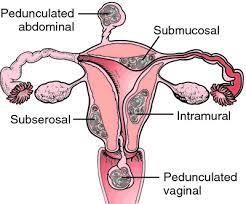A 40-year-old female presents with cramping and excessive vaginal bleeding. Ultrasound reveals benign uterine tumors in the smooth muscle cells of the myometrium. These tumors are commonly called:
adenomas
leiomyomas
endometriosis.
adenomyosis
The Correct Answer is B
Choice A rationale: Adenomas are benign tumors that originate from glandular tissue, such as the endometrium, the inner lining of the uterus.
Choice B rationale: Leiomyomas, also known as fibroids, are benign tumors that arise from the smooth muscle cells of the myometrium, the middle layer of the uterine wall. They are the most common type of uterine tumors, affecting up to 80% of women by age 50. They can cause symptoms such as heavy menstrual bleeding, pelvic pain, pressure, and infertility.
Choice C rationale: Endometriosis is a condition where endometrial tissue grows outside the uterus, causing inflammation and pain.
Choice D rationale: Adenomyosis is a condition where endometrial tissue invades the myometrium, causing enlargement and distortion of the uterus.

Nursing Test Bank
Naxlex Comprehensive Predictor Exams
Related Questions
Correct Answer is D
Explanation
Choice A rationale: This is a possible sign of TBI but is not necessarily indicative of a life- threatening condition.
Choice B rationale: This is a possible sign of TBI but is not necessarily indicative of a life- threatening condition.
Choice C rationale: This is a possible sign of TBI but is not necessarily indicative of a life- threatening condition.
Choice D rationale: Serosanguineous nasal drainage (a mixture of blood and clear fluid) may suggest a basilar skull fracture, which is a fracture of the base of the skull that can damage vital structures such as the brainstem, cranial nerves, or major blood vessels. This can lead to serious complications such as meningitis, cerebrospinal fluid leak, or hemorrhage.
Correct Answer is ["A","B","C","D","E"]
Explanation
Choice A rationale: This is a condition where the skin of the breast becomes dimpled and resembles an orange peel. It is caused by blockage of the lymphatic vessels by cancer cells or inflammation.
Choice B rationale: This is a condition where the skin of the breast breaks down and forms an open sore. It can be a sign of advanced or inflammatory breast cancer.
Choice C rationale: This is a condition where the nipple becomes inverted or pulled inward. It can be caused by scarring, infection, or cancer in the breast tissue or ducts.
Choice D rationale: These are lymph nodes in the armpit that are enlarged and hard but not painful. They can be a sign of cancer spreading from the breast to the lymphatic system.
Choice E rationale: This is a lump in the breast that can be felt and moved around. It is located at the upper outer quadrant of the right breast, as if looking at a clock face. It can be benign or malignant, depending on its size, shape, consistency, and borders.
Choice F rationale: Dense breast tissue is not an abnormal finding that indicates possible breast cancer. It is a normal variation that makes it harder to detect lumps or
abnormalities on mammograms. Women with dense breasts may need additional screening tests such as ultrasound or MRI.
Whether you are a student looking to ace your exams or a practicing nurse seeking to enhance your expertise , our nursing education contents will empower you with the confidence and competence to make a difference in the lives of patients and become a respected leader in the healthcare field.
Visit Naxlex, invest in your future and unlock endless possibilities with our unparalleled nursing education contents today
Report Wrong Answer on the Current Question
Do you disagree with the answer? If yes, what is your expected answer? Explain.
Kindly be descriptive with the issue you are facing.
